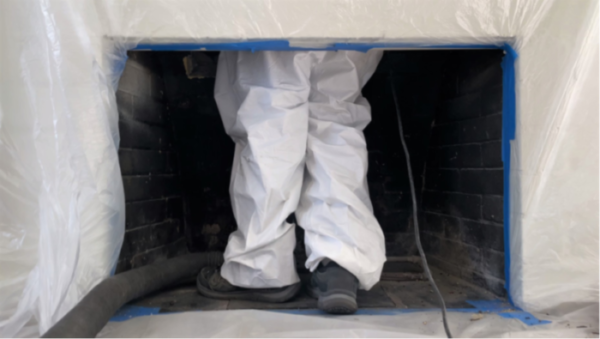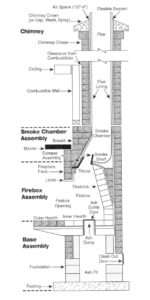It’s Really Quite Simple
Please do not try at home. Trained professional on closed course.
Mike Rees, AKA The Chimney Guy was opening another piece of fan mail, minding his own business. He read:
“Dear Chimney Guy, I’m a real estate agent and I hear chimney inspectors talk about chimneys all the time and I get confused about what all those words mean.”
“What DO they mean?”
(For what follows, please refer to the chimney diagram thoughtfully provided by your editor, see page two.)
The Chimney Guy thought a moment and then put pen to paper:
“Well, let’s start out with a regular masonry chimney.
“And let’s start at the bottom.
“For most chimneys in the LA area, the BASE of the
“chimney is below the floor, in the crawl space. The BASE supports the entire weight of the brickwork above it, so it’s important that it be in decent condition. Sometimes the mortar in between the bricks starts turning sandy and no longer does a good job at holding the bricks together. Usually we can grind out the sandy mortar and push fresh
“mortar into the joint. Sometimes things are too bad and there is very little mortar left and the bricks are actually sagging down. When it gets that bad, we have to recommend a complete tear down to the ground and start over.
“Above that we find the HEARTH. This is the floor of the fireplace. We sometimes make a distinction between the INNER HEARTH, which is inside the fireplace, and the OUTER HEARTH, which is what sticks out in front of the fireplace.
“Then we can see what most people are familiar with, the FIRPLACE, also called the FIREBOX. This is where wood goes or where a set of gas logs would go. It’s where the fire is.
“The FIREBOX usually has two SIDEWALLS and a BACKWALL.
“At the top of the BACKWALL we often find a DAMPER. This is a metal plate with a handle. It is used to close off the flow of air or gases upwards or downwards. Its main use is to close off the flow of cold air down the chimney when there is no fire in the fireplace. If one has a gas-only setup, like gas logs, then we are supposed to rig the damper so it stays open all the time. This is a safety feature so that someone
“can’t start a gas fire with the damper closed. In that case none of the gases produced by the fire, including carbon monoxide, would go up the chimney. They would all flood out into the room. They’re usually invisible and people might not smell any gases. But the carbon monoxide is hazardous.
“Then we have the BREASTPLATE, which is part of the SMOKE CHAMBER. This is the space directly above the firebox. This is like an upside-down funnel, which is wide at the bottom and narrow at the top, and it funnels the smoke up to the bottom part of the FLUE.
“The FLUE is the long narrow tube which carries the smoke up and out the top of the chimney.
“The very top structure is often a layer of concrete which has the purpose of causing rainwater to flow off to the sides so it doesn’t soak down into the brickwork, where it can cause damage. This top part is called the CROWN. (Like the crown a king or queen might wear on top of their heads. Get it?)
“Anyway…
“The last thing is called the SPARK ARRESTER CAP, or sometimes just the CAP. This is a metal cage with a lid on top. The cage helps keep sparks and embers coming out
“of the flue from escaping and trying to get things burning, like trees, shrubs or a shingle or shake roof. The lid keeps most of the rain from getting inside the flue.
“Most of the parts of the chimney have the job of keeping flames or hot gases or plain old heat from getting too close to the wood structure of the house.
“When cracks or gaps develop, they should be repaired.”
May all your dreams be lofty.
The Chimney Guy, Inc.
———————————————————-
Copyright © 2021, The Chimney Guy, Inc.


